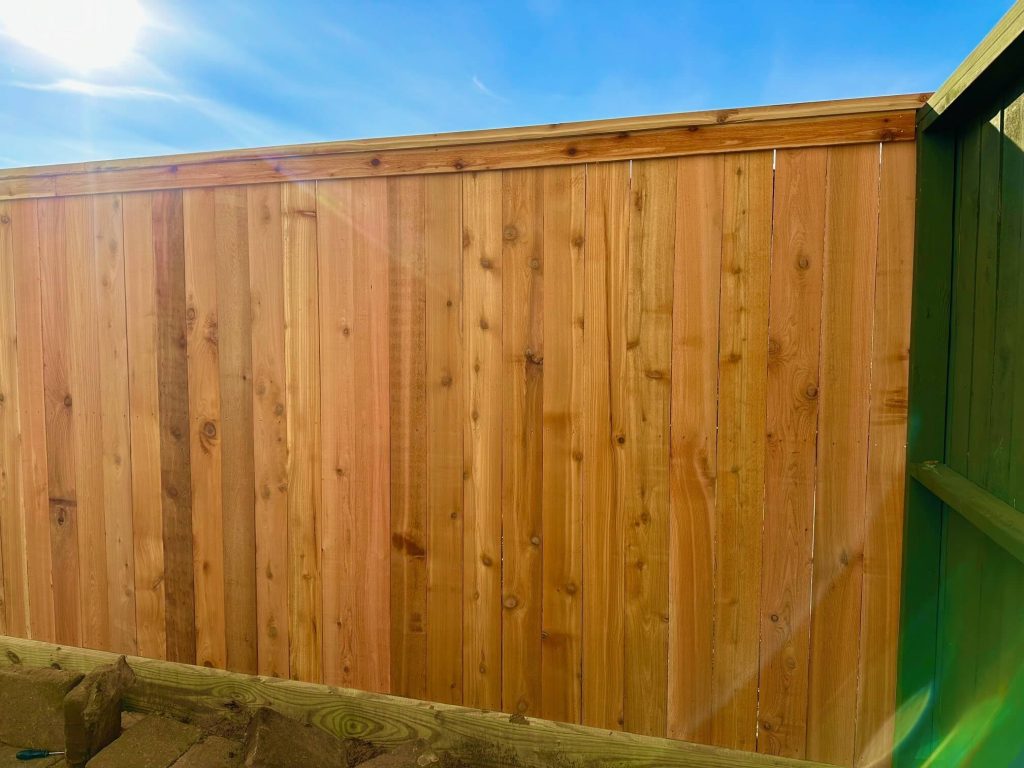Privacy Fence: Design Ideas, Materials & Installation Tips
Imagine the serenity of enjoying your backyard oasis without worrying about prying eyes, intrusive noise or unwanted guests. Privacy fences are essential for creating a personal paradise right in your home’s backyard. Our comprehensive guide on privacy fences covers innovative design ideas, details on the most beneficial materials, and essential installation tips to transform your outdoor space. Say goodbye to neighbors peering into your sacred area and embrace the freedom that comes with a well-built, stylish privacy fence.

Benefits of Adding a Privacy Fence
Adding a privacy fence to your property offers a myriad of benefits that go beyond simply creating a secluded and intimate outdoor space.
First and foremost, enhanced privacy is one of the primary reasons homeowners opt for privacy fences. These fences provide a physical barrier that shields your property from prying eyes, creating a sense of seclusion and tranquility in your outdoor living area. Whether you’re lounging by the pool, hosting a backyard gathering, or enjoying a quiet evening with loved ones, having a privacy fence ensures that you can relax without worrying about neighbors or passersby intruding on your personal space.
Picture this: You’ve just moved into your dream home with a spacious backyard. You envision spending quality time with family and friends, hosting summer barbecues, and creating lasting memories. However, there’s one problem — your yard is exposed to the neighboring properties. By installing a privacy fence, you transform your open yard into an oasis where you can enjoy private moments away from prying eyes.
Beyond privacy, security is another significant benefit of adding a privacy fence to your property. Privacy fences act as deterrents to would-be intruders, making it more challenging for them to access your home or outdoor spaces. The barrier created by these fences acts as an additional layer of protection for your family and possessions. Moreover, if you have children or pets, a privacy fence provides peace of mind by keeping them safely contained within your property boundaries.
But the benefits don’t stop at privacy and security alone. A privacy fence can also significantly reduce noise pollution from nearby roads or busy neighborhoods. The solid construction of these fences helps absorb sound waves, providing you with a more peaceful and tranquil environment within your property.
In addition to practical advantages, installing a privacy fence can also have a positive impact on your property’s aesthetic appeal and value. These fences come in various materials, designs, and styles, allowing you to choose one that complements the architectural style of your home and aligns with your personal taste. By enhancing the overall appearance of your property, a privacy fence can increase its curb appeal and potentially attract more potential buyers if you ever decide to sell.
Enhancing Security and Privacy
When it comes to creating a secure and private environment for your home, a well-designed privacy fence plays a crucial role. Not only does it provide physical barriers, but it also acts as a psychological deterrent against unauthorized access. Let’s delve deeper into how a privacy fence enhances security and privacy.
One of the primary ways in which a privacy fence enhances security is by restricting visibility from the outside. By obstructing the view into your property, potential intruders are less likely to target your home as they cannot easily assess valuable belongings or activities happening within. This added layer of protection can discourage criminals and trespassers from attempting to gain unauthorized access to your property.
Furthermore, installing a privacy fence helps establish clear property boundaries, reducing the chances of disputes with neighbors over encroachments or possible misunderstandings. The clear demarcation offered by these fences promotes neighborly relations and ensures mutual respect of each other’s spaces.
Privacy fences also offer sound insulation benefits by reducing noise pollution from external sources. They create a barrier that effectively absorbs and deflects sound waves from busy streets or noisy surroundings, allowing you to enjoy outdoor activities or simply relax without disturbances.
In addition to these security and noise reduction benefits, privacy fences also enhance your overall sense of privacy by creating an enclosed space exclusively for you and your family. Whether you’re sunbathing, gardening, or enjoying a cozy evening on your patio, a privacy fence provides a comforting shield from the outside world, allowing you to fully relax and enjoy your personal space.
Imagine yourself sitting in your backyard during a summer evening, reading a book and sipping your favorite drink. With a privacy fence surrounding your property, you are shielded from the prying eyes of neighbors or passersby. You can let go of any worries about outsiders observing or intruding upon your tranquil moment. Instead, you can fully immerse yourself in the peace and serenity of your own outdoor sanctuary.
Privacy Fence Design Ideas
When it comes to privacy fence design ideas, there are numerous options to consider. Your choice should align with the overall aesthetic of your property while also providing the desired level of privacy and security. Let’s explore some popular design ideas to inspire your project.
Classic Wooden Design
A classic wooden privacy fence is a timeless choice that exudes warmth and adds natural beauty to any outdoor space. Wood offers versatility in terms of design, as you can opt for different styles, heights, and finishes to suit your preferences. Whether you prefer a traditional picket fence or a solid board design, wood provides a rustic charm that complements various architectural styles.
Imagine walking through a neighborhood adorned with lovely houses, each surrounded by pristine wooden privacy fences. The rich warmth of the wood grain creates an inviting atmosphere and a sense of seclusion, transforming your backyard into a private oasis.
When considering a classic wooden design for your privacy fence, it’s important to select durable species like cedar or redwood that are resistant to rot and decay. These materials withstand the elements well and require minimal maintenance over time. Keep in mind that regular staining or sealing may be necessary to enhance the wood’s lifespan and appearance.
Wooden fences offer excellent customization options. You can choose from a range of decorative accents such as lattice work, post caps, or even incorporate a gate for added convenience. This allows you to personalize your fence according to your taste and needs, creating a unique look that stands out among other properties.
With its traditional appeal and ability to seamlessly blend with various landscapes, the classic wooden design remains a popular choice for homeowners seeking both privacy and aesthetic appeal.
Modern Aluminum Look
When it comes to achieving a sleek, contemporary appearance for your privacy fence, the modern aluminum look is an excellent choice. Aluminum fences have gained popularity in recent years due to their durability, low maintenance requirements, and stylish aesthetic. With their clean lines and minimalist design, these fences effortlessly blend into modern landscapes, creating an elegant and sophisticated look.
Imagine a backyard oasis with a sleek, white modern aluminum fence encircling it. The straight horizontal slats add a touch of modernity and openness while still maintaining the privacy you desire. This type of fencing not only enhances the overall visual appeal of your property but also provides security without obstructing the view of your surroundings.
One key advantage of aluminum fences is their versatility in terms of design options. You can choose from various styles, such as flat-top or spear-top, depending on your personal preferences and the overall aesthetics you wish to achieve. Additionally, they often come in a range of colors and finishes, allowing you to customize the fence to perfectly complement your home’s exterior.
Another advantage is their durability. Aluminum fences are resistant to rust and rot, making them suitable for both humid and coastal environments. They are also lightweight yet sturdy, offering longevity and strength without compromising on aesthetic appeal. Unlike other materials like wood, aluminum fences do not require regular staining or painting, saving you time and effort in maintenance.
Installation of modern aluminum fences is generally straightforward due to their pre-fabricated nature. The lightweight panels are easy to handle and can be installed relatively quickly compared to other types of fencing materials. However, it is essential to hire a professional fence installer who has experience working with aluminum fences to ensure proper installation and optimal performance.
If you’re seeking a modern and stylish privacy fence that requires minimal maintenance while providing security and durability for your property, the modern aluminum look is an ideal choice.
Ornate Ironwork Styles
For those yearning for a timeless and sophisticated aesthetic, ornate ironwork styles are an excellent option for privacy fences. Iron fences have been admired for centuries for their elegance, durability, and ability to add a touch of grandeur to any property. With their intricate designs and attention to detail, these fences create a sense of luxury and refinement.
Envision a beautifully crafted iron fence adorned with decorative scrolls, twists, and finials that enhance the overall curb appeal of your home. The ornate patterns cast intriguing shadows and create an inviting atmosphere around your property. Iron fences can be customized to meet your desired level of privacy while maintaining an open feel and providing a panoramic view of the exterior surroundings.
The versatility of ornate ironwork allows you to explore various design options depending on the architectural style of your home. Whether you prefer a more traditional look with Victorian-inspired scrolls or a contemporary design with geometric patterns, iron fences offer endless possibilities for personalization.
Despite their intricate appearance, iron fences are built to last. They are incredibly durable and resistant to harsh weather conditions. Properly maintained iron fences can withstand the test of time, maintaining their timeless charm for years to come.
It is important to note that iron fences do require regular maintenance to prevent rust and keep them looking their best. Periodic painting or applying protective coatings will help ensure the longevity of your fence while preserving its beauty.
When considering ornate ironwork styles for your privacy fence, it is advisable to consult with a professional fence installer who specializes in iron fencing. They can provide guidance on the best design choices based on your needs and preferences while ensuring proper installation techniques are implemented.
If you desire a privacy fence that exudes elegance and sophistication with intricate designs that stand the test of time, ornate ironwork styles are an excellent choice.
Cost of Installing a Privacy Fence
When it comes to installing a privacy fence, cost is undoubtedly an important factor to consider. The total expenses can vary significantly based on several factors, such as the material chosen, the height and length of the fence, and the complexity of the installation process. Let’s take a closer look at these cost considerations.
1. Material: The choice of material will greatly impact the overall cost of installing a privacy fence. Wood, vinyl, aluminum, and composite are common options available in the market, each with its own price range. For example, wood fences tend to be more affordable upfront but may require more maintenance in the long run.
2. Height and Length: The height and length of your desired privacy fence will directly influence the cost. Taller fences or longer stretches of fencing will naturally require more material and labor for installation, resulting in higher expenses. When planning your project, make sure to measure accurately to estimate the amount of materials needed and obtain accurate cost estimates.
3. Complexity of Installation: The complexity of the installation process is another key factor affecting costs. Factors such as uneven terrain, existing obstacles like trees or rocks, or even special design features can increase the difficulty level of installation, requiring additional time and effort from the professionals involved. Keep in mind that these complexities may escalate project costs.
Steps in Privacy Fence Installation
Installing a privacy fence may seem like an overwhelming task, but approaching it step by step can simplify the process. Here are some essential steps to guide you through a successful privacy fence installation:
1. Planning and Design: Begin by identifying your property lines and determining where you want your privacy fence to be installed. Take measurements and consider factors like the desired height and any specific design elements you want to incorporate. This planning phase will help you gather accurate estimates and ensure compliance with local regulations.
2. Obtaining Permits: Depending on your location, you may need to obtain permits before proceeding with the installation. Check with your local authorities or homeowner’s association to ensure compliance with any rules or regulations regarding fence installations. Failure to obtain necessary permits can result in potential legal complications in the future.
3. Material Selection: Choose the appropriate fencing material based on your preferences, budget, and maintenance requirements. Consider factors such as durability, appearance, and longevity to make an informed decision that aligns with your needs.
4. Preparation and Marking: Once you have determined the fence line, the next step is to mark it accurately on the ground using stakes and string. This will serve as a guide during the installation process. Additionally, clear any vegetation or debris along the fence line for ease of construction.
5. Digging Post Holes: Dig post holes along the marked fence line at regular intervals. The depth of these holes will depend on various factors such as soil conditions and desired fence height. It is important to ensure that the post holes are deep enough for stability and support.
6. Installing Fence Posts: Insert the fence posts into the dug holes and firmly secure them with concrete or gravel for stability. Use a level to ensure that each post is plumb and properly aligned.
7. Attaching Rails and Panels: Install horizontal rails along the posts, followed by attaching privacy panels or pickets to create a solid barrier. Make sure to secure these components firmly according to manufacturer guidelines while maintaining consistent spacing for an aesthetically pleasing result.
8. Adding Finishing Touches: Once the main structure is in place, add any finishing touches such as post caps or decorative elements to enhance the appearance of your privacy fence.
By following these steps and paying attention to detail throughout each stage of the process, you can successfully install a privacy fence that provides security, privacy, and added beauty to your property.
Site Preparation
Before embarking on the installation of a privacy fence, proper site preparation is crucial to ensure a sturdy and long-lasting structure. Taking the time to adequately prepare the site will contribute to the overall success of your fence installation project.
Firstly, it’s essential to accurately mark the boundary lines of your property. This can be done by consulting property surveys or contacting a professional land surveyor to determine the exact boundaries. Clearing any brush, debris, or vegetation along the fence line is also necessary. Not only does this ensure a clean and even surface for installation, but it also prevents potential obstructions or damage to the fence in the future.
Next, checking local regulations and obtaining any necessary permits is an important step. Depending on your municipality, there may be specific guidelines or restrictions regarding fence height, placement, and materials. By familiarizing yourself with these regulations beforehand, you can avoid potential issues and ensure compliance.
Once you’ve addressed these preliminary concerns, it’s time to consider the terrain of your property. If the ground is uneven or slopes significantly, additional steps may be required for proper installation. Leveling the ground using techniques like filling low spots with soil or removing excess soil from high areas helps achieve a more even surface and facilitates easier fence installation.
Lastly, locating any underground utilities such as water lines, gas lines, or electrical cables is crucial for avoiding accidents during installation. Contacting your local utility companies can provide you with information about underground obstructions and help prevent dangerous mishaps.
Site preparation sets the foundation for a successful privacy fence installation project. By clearing the area, checking regulations and obtaining permits when necessary, addressing the terrain, and identifying underground utilities, you’ll be well-prepared to proceed with the next step: post setting.
Post Setting
The process of setting fence posts is critical, as they provide the framework and support for your privacy fence. Ensuring that the posts are firmly planted will help maintain the overall stability and longevity of your fence.
Before starting the post-setting process, it’s essential to gather all the necessary tools and materials. This typically includes posts, concrete mix, a level, a posthole digger or auger, gravel for drainage, water source for mixing concrete, and braces to hold the posts in position while they set.
To begin, mark the exact placement of each post along the fence line. Using a posthole digger or auger, carefully dig holes at least one-third of the total length of the posts. The depth depends on several factors such as soil type and frost line depth prevalent in your region. Typically, a depth of around 2-3 feet is recommended for stability.
After digging the holes, it’s beneficial to add a layer of gravel at the bottom to improve drainage and prevent water accumulation around the posts. Place the post into the hole and use a level to ensure it is perfectly plumb vertically and aligned with adjacent posts horizontally.
Imagine you’re building a privacy fence to enclose your backyard oasis. You meticulously dig each posthole with care and attention, ensuring they are aligned perfectly. This level of precision will contribute to not only a visually pleasing fence but also its structural integrity.
Once you have confirmed each post’s alignment and plumbness, it’s time to secure them in place with concrete. Mix concrete according to manufacturer instructions or consider using quick-set concrete for faster results. Fill each hole with concrete, making sure to leave enough space at the top for a slightly dome-shaped finish, allowing water to flow away from the post.
After pouring the concrete, use braces or supports to hold the posts in position until the concrete sets. This prevents any shifting or misalignment during the curing process. Be sure to remove any excess concrete around the base of each post before it dries.
Fence Panel Installation
When it comes to installing a privacy fence, the installation of fence panels is a crucial step. Fence panels not only provide security and privacy but also contribute to the aesthetic appeal of your property. In this section, we will walk you through the process of fence panel installation, ensuring that you have all the necessary information to complete this task successfully.
Before diving into the installation process, it’s important to gather all the materials and tools you will need. These typically include fence panels, posts, concrete mix, gravel or crushed stone for the post holes, screws or nails for attaching the panels, and a level for ensuring proper alignment.
The first step in fence panel installation is to prepare the area where the fence will be installed. Start by marking out the location of each post using stakes and string. Make sure to measure accurately and mark these positions evenly along your desired fence line.
Once you have marked out the post locations, it’s time to dig the post holes. The depth and diameter of the holes will depend on various factors such as soil type, local building codes, and the height of your fence panels. Typically, holes should be dug at least 1/3rd of the height of the fence panel plus 6 inches deeper to allow for proper stability.
After digging the post holes, place gravel or crushed stone at the bottom to provide drainage and prevent posts from sinking over time. Next, set your posts securely in each hole, making sure they are level both vertically and horizontally using a level. Once properly aligned, pour concrete around the posts and let it set according to manufacturer instructions.
Let’s say you are installing wooden fence panels. After allowing sufficient time for concrete to cure, attach brackets or rails to each post at the appropriate height for securing your fence panels. Position your first panel against these brackets or rails and secure it with screws or nails. Use a level to ensure that the panel is straight and plumb before moving on to the next one.
Continue attaching panels in a similar manner until you have completed the fence line. It’s important to check the alignment and level of each panel as you go along to ensure a straight and seamless installation. Trim any excess length from the final panel if necessary.
Installing fence panels is like assembling a puzzle, piece by piece, until the entire picture comes together. Each panel contributes to the overall strength and appearance of your privacy fence, so it’s crucial to take your time and make sure everything fits snugly.
Once all your fence panels are securely attached, step back and admire your finished installation. The hard work and attention to detail will pay off as you enjoy the privacy and beauty that your new fence provides.
And if you are ready to let the professional handle your privacy fence installation, reach out to us at Texas Fence!








